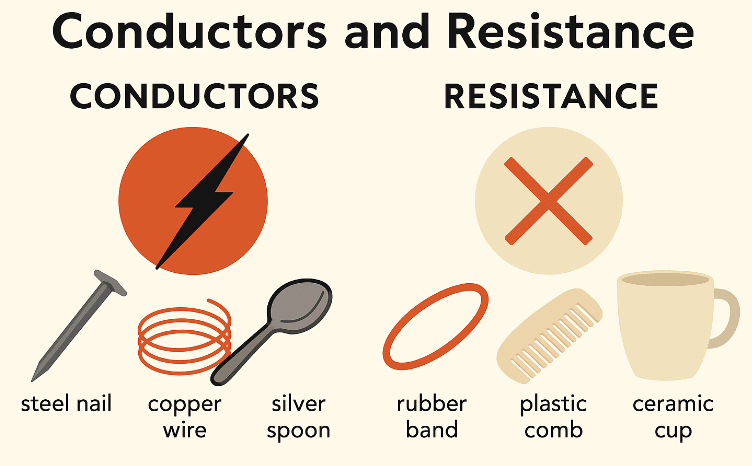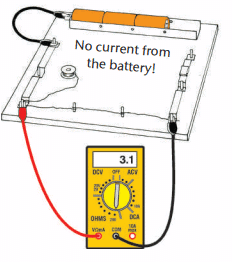Resistance and Factors that change it Chapter Notes | Technical Science for Grade 10 PDF Download
| Table of contents |

|
| Conductors and Resistance |

|
| Conductors and Insulators |

|
| Design Resistors to Control Currents |

|
| Practical Applications |

|
| Points to Remember |

|
| Difficult Words |

|
| Summary |

|
Conductors and Resistance
This section introduces resistance, its relationship with voltage and current, and how different materials affect resistance due to their resistivity. It explains how resistance is measured and its role in controlling current.

Resistance
Definition: Resistance is the opposition to the flow of electric current in a circuit, measured in ohms (Ω), where 1 Ω = 1 volt per ampere (V/A).Effect on Current:
- Higher resistance reduces current, making it harder for charges to flow.
- Lower resistance increases current, allowing easier flow.
Example: In a circuit with one cell and a bulb, adding more bulbs in series increases resistance, dimming the indicator bulb as the current decreases.
Mechanism:
- Electric charges (electrons) in a resistor collide with metal atoms, transferring energy to them.
- This energy heats the resistor, slowing the charges and opposing their flow.
Conductors and Insulators
Good Conductors: Materials with low resistance, allowing easy current flow.- Examples: Copper, gold, silver, aluminium.
- Use: Wiring in circuits due to minimal energy loss.
Medium-Bad Conductors: Materials with moderate resistance, conducting electricity but less efficiently.
- Examples: Tungsten (used in bulb filaments), graphite (in pencils), nichrome (used in resistors).
- Use: In components like bulbs or heaters where resistance produces heat or light.
Semi-Conductors: Materials like silicon or germanium mixed with elements like phosphorus.
- Behavior: Resistance decreases as voltage increases or temperature rises, improving conductivity.
- Use: In electronics like computers and LEDs.
Insulators (Very Bad Conductors): Materials with extremely high resistance, preventing current flow.
- Examples: Plastic, glass, wood, dry air.
- Use: Insulation on wires to prevent unwanted current flow.
Exception: Insulators can conduct at very high voltages (e.g., air conducts lightning at millions of volts).
Resistivity
Definition: Resistivity is the inherent property of a material to resist current flow, independent of its shape or size.Contrast with Resistance:
- Resistance depends on an object’s length, thickness, and shape.
- Resistivity depends only on the material’s nature (e.g., copper vs. plastic).
Reason for Resistivity:
- In good conductors (e.g., copper), many electrons are free to move between atoms, allowing easy current flow.
- In insulators (e.g., plastic), electrons are tightly bound to atoms, preventing movement.
Electron Movement:
- Electrons (negatively charged) are pulled by an electric force but collide with positive nuclei in metal atoms.
- At 1 ampere, 6.25 × 1018 electrons pass a point per second, causing vibrations that heat the material.
Resistivity Scale:
- Very low resistivity: Silver, copper, gold, aluminium.
- Moderate resistivity: Nichrome, graphite, wet paper with salt water, wet human skin.
- High resistivity: Plastic, glass, dry paper, dry air.
Measuring Resistance
Unit: Resistance is measured in ohms (Ω).Methods:
Comparing Current and Voltage:
Resistance is the ratio of voltage (V) to current (I).
Formula: R = V / I
- R: Resistance (ohms, Ω).
- V: Voltage (volts, V).
- I: Current (amperes, A).
Example: For a copper wire, 2 V pushes 2 A, so R = 2 / 2 = 1 Ω; 3 V pushes 3 A, R = 3 / 3 = 1 Ω (constant ratio).
Rearranged Formulas:
- V = I × R (to find voltage).
- I = V / R (to find current).
Using an Ohm-Meter:
A multimeter set to the resistance range (e.g., 200 Ω) measures resistance directly.
 Process:
Process:
- Turn off the circuit’s power to avoid damage.
- Connect red and black leads to the component’s ends (e.g., nichrome wire).
- Display shows resistance in ohms; touching leads together shows ~0 Ω.
Examples:
- Nichrome wire with 6 V and 2 A: R = 6 / 2 = 3 Ω.
- Bulb with 1.4 V and 0.5 A: R = 1.4 / 0.5 = 2.8 Ω.
Role of Resistors
Purpose: Resistors control current in electrical devices to ensure safe operation.Example: In a radio, resistors (small colored cylinders) limit current to specific parts, allowing small currents for some components and larger currents for others.
Construction:
- Made from carbon, with resistance adjusted by cutting away material.
- Colored bands indicate resistance value, following a code (found in Resource Pages).
Stability: Carbon resistors maintain constant resistance, ensuring consistent performance.
Design Resistors to Control Currents
This section explores the four factors affecting a conductor’s resistance—length, thickness, temperature, and material—and their practical applications in designing circuits.
Factors Affecting Resistance
Overview: The resistance of a conductor depends on:- Length of the conductor.
- Thickness (diameter) of the conductor.
- Temperature of the conductor.
- Substance (material) the conductor is made from.
Length of the Conductor
Effect: Longer conductors have higher resistance.Reason: Electrons must travel further, encountering more atoms to collide with, which increases opposition to current flow.
Application:
- In bulb filaments, long, thin tungsten wires are used to increase resistance, ensuring the filament (not the copper wires) produces light and heat.
- Example: A 1 mm wide tungsten filament coil, when uncoiled, is much longer, increasing its resistance significantly.
Thickness of the Conductor
Effect: Thicker conductors have lower resistance.Reason: A larger cross-sectional area allows more electrons to flow simultaneously, reducing opposition.
Application:
- Thick copper wires are used for high-current devices like stoves to minimize resistance and energy loss.
- Thin wires are used for low-current devices like lights, where higher resistance is acceptable.
- Example: Using thin wires for a stove would increase resistance, causing overheating and potential fire hazards.
Temperature of the Conductor
Effect: Higher temperatures increase resistance in most conductors (e.g., metals like nichrome or tungsten).
Reason: Heat causes atoms to vibrate more, increasing collisions with electrons and hindering current flow.
Exceptions:
- Semi-conductors (e.g., silicon) have lower resistance at higher temperatures, as heat frees more electrons for conduction.
- Supercooled conductors (e.g., in MRI machines at -269.1°C with liquid helium) have extremely low resistance, allowing large currents.
Applications:
- Computer circuits are cooled with fans to reduce resistance, improving speed and efficiency.
- Hot bulb filaments have higher resistance than cold ones, affecting current flow.
- Overheated extension cables (e.g., coiled on a reel) can melt insulation due to increased resistance and heat buildup.
Material of the Conductor
Effect: Different materials have different resistivities, affecting resistance.Reason: The atomic structure determines how easily electrons move (e.g., copper has many free electrons, aluminium fewer, iron even fewer).
Applications:
- Copper is preferred for cables due to low resistivity, but aluminium is used to deter theft, despite higher resistance and energy loss.
- Iron wires, with higher resistivity than copper, would reduce current and efficiency if used in place of thick copper cables (e.g., in car batteries).
- Tungsten is chosen for bulb filaments due to its high resistance and ability to glow brightly at high temperatures without melting.
Practical Applications
- Bulb Filaments: Engineers use long, thin tungsten wires to achieve high resistance, ensuring the filament glows while copper wires remain low-resistance.
- House Wiring: Thick copper wires for stoves reduce resistance for high currents; thinner wires suffice for lights.
- MRI Machines: Supercooled wires reduce resistance, enabling large currents for strong electromagnets.
- Computers: Cooling reduces resistance in thin conductors, speeding up calculations.
- Car Batteries: Thick copper cables minimize resistance for high-current starter motors; thinner or iron wires would reduce performance.
- Welding Machines: Coiled extension cables increase resistance and heat, risking insulation damage; unwinding cables prevents this.
Points to Remember
- Resistance opposes current flow, measured in ohms (Ω), where 1 Ω = 1 V/A.
- Good conductors (e.g., copper, silver) have low resistance; medium-bad conductors (e.g., tungsten, nichrome) have higher resistance; insulators (e.g., plastic, glass) have extremely high resistance.
- Semi-conductors (e.g., silicon) have decreasing resistance with higher voltage or temperature.
- Resistivity is a material’s inherent ability to resist current, unlike resistance, which depends on length, thickness, and shape.
- Electrons collide with metal atoms, heating the conductor and causing resistance; 1 A involves 6.25 × 1018 electrons per second.
- Resistance is measured by comparing voltage and current (R = V / I) or using a multimeter’s ohm-meter setting.
- Resistors (e.g., carbon cylinders) control current in devices like radios, with resistance indicated by colored bands.
- Resistance increases with longer conductors, as electrons face more atomic collisions.
- Thicker conductors have lower resistance, allowing more electron flow.
- Higher temperatures increase resistance in metals but decrease it in semi-conductors; supercooled conductors have very low resistance.
- Material affects resistance: copper has lower resistivity than aluminium or iron, tungsten is used for high-resistance filaments.
- Practical designs use resistance factors: long, thin tungsten for bulbs, thick copper for stoves, cooled wires for MRI machines, and aluminium cables to deter theft.
Difficult Words
- Resistance: The opposition to electric current flow in a circuit, measured in ohms (Ω).
- Ohm (Ω): The unit of resistance, equal to 1 volt per ampere.
- Conductor: A material (e.g., copper) that allows current to flow easily due to low resistance.
- Insulator: A material (e.g., plastic) with high resistance, preventing current flow.
- Semi-Conductor: A material (e.g., silicon) whose resistance decreases with higher voltage or temperature.
- Resistivity: A material’s inherent ability to resist current, independent of size or shape.
- Nichrome: A medium-bad conductor used in resistors, with higher resistance than copper.
- Tungsten: A medium-bad conductor used in bulb filaments, with high resistance and heat tolerance.
- Multimeter: A device that measures voltage, current, or resistance, including an ohm-meter setting for resistance.
- Carbon Resistor: A component with fixed resistance, marked with colored bands, used to control current.
- Filament: A thin wire (e.g., tungsten) in a bulb that glows due to high resistance and heat.
- MRI Machine: A medical device using low-resistance, supercooled wires to generate strong magnetic fields.
Summary
Chapter 14 examines electrical resistance and the factors that influence it. Resistance, measured in ohms, opposes current flow, with higher resistance reducing current and lower resistance increasing it. Good conductors like copper have low resistance, medium-bad conductors like tungsten and nichrome have higher resistance, and insulators like plastic have extremely high resistance. Semi-conductors reduce resistance with heat or voltage. Resistivity, a material’s inherent resistance property, explains why copper conducts better than plastic due to free electrons. Resistance is measured by dividing voltage by current (R = V / I) or using a multimeter’s ohm-meter. Resistors, such as carbon cylinders, control current in devices, with resistance coded by colored bands. Resistance depends on four factors: longer conductors increase resistance, thicker conductors decrease it, higher temperatures increase it in metals (but decrease it in semi-conductors), and materials like copper have lower resistivity than aluminium or iron. These factors are applied in bulb filaments, house wiring, MRI machines, computer circuits, car batteries, and welding cables to optimize performance and safety.
FAQs on Resistance and Factors that change it Chapter Notes - Technical Science for Grade 10
| 1. What are the main differences between conductors and insulators? |  |
| 2. How does resistance affect the flow of electric current in a circuit? |  |
| 3. What factors can change the resistance of a material? |  |
| 4. How can resistors be designed to control currents in electrical circuits? |  |
| 5. What are some practical applications of resistors in everyday devices? |  |



















